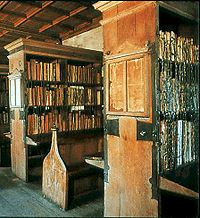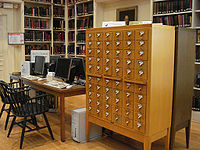Technology in the Library
From booktorrent
Contents |
Technology
Technology, can be defined as "a manner of accomplishing a task especially using technical processes, methods, or knowledge.[3]" Its use and development in society has led to changes in the roles of the librarians and library staff using it. This comes about by changing the materials libraries must handle, the way materials are processed and preserved, and the way materials are accessed and distributed by and to patrons.
Early Technology in Libraries

When scrolls were used to store information, the scrolls themselves were kept in sleeves, boxes, or shelves subdivided into pigeonholes. Scrolls had to be labeled on their outmost end for identification, and organization was up to the librarian.
Scrolls gave way to books through design out of necessity that made it so instead of having to unfurl an entire scroll to get to a particular passage, one might fold the scroll accordion-style and simply flip to the appropriate page. Over time, the long strip of material was replaced with loose leaves. Bindings made it so that the associated materials stayed together in order.
Books were hand written for many centuries before the printing press came to use, and so they were scarce and valuable. To keep texts safe, book chests were used, and chains tied books to lecterns and shelves.
As book production picked up, the use of chains became impractical. They got tangled and were a nuisance when removing one book from the rest of the collection, as the chain could only be removed by pulling out the rod the chain attached to and taking off all preceding chains (and then putting them back on when one is done).
After Johannes Gutenberg's printing press came to popular use in Europe, book manufacture and distribution increased dramatically and the price of individual copies came down. Eventually, books no longer had to be chained to protect against theft.
The Modern Era

As libraries grew, particularly in public libraries, it became necessary to catalog each book in such a way as could be identified remotely and then located in the physical stacks. It was important that anyone could easily learn the organizational system, as librarians and patrons would be using it. And so the card cataloging system came to be, wherein each book in circulation had its corresponding card in a specialized cabinet. The card often had information including the the book's Dewey Decimal number, title and author, the date of publication, physical characteristics of the book, and a Library of Congress-style listing of the book's contents.
"Since the 1960s, libraries have used technology in general, and computers in particular, to automate a wide range of administrative, public, and technical services tasks.[4]" Computers have become the basic equipment in most American libraries, and are used at the front desk when checking in and out materials, as research terminals for patrons, as an access terminal to the digital catalog, and as remote access to library information via the Internet and library websites, among other uses.
Technological Future
???
